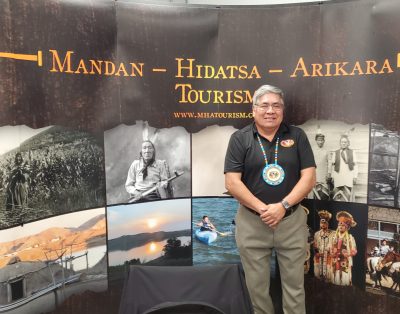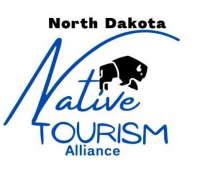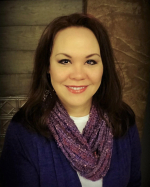*Stories marked with an asterisk were written by experienced contributing editors with the goal of showing North Dakota's diversity.

The sounds of drums, singing and jingles fill the auditorium. Hundreds of people, including students, teachers, and community members, have gathered throughout the day to learn more about the Mandan, Hidatsa, Arikara (MHA) Nation. They listen intently to Charlie Moran as he explains the meaning behind each powwow dance. “...This is a jingle dress. Each jingle represents a prayer...” He goes on to share the story of how the jingle dress dance came to be, along with several other stories.

Charlie is one of several storytellers and culture bearers who were at the first annual Native American Heritage Month (NAHM) celebration created by the North Dakota Native Tourism Alliance (NDNTA), the MHA Nation, and the State Historical Society of North Dakota. It was held November 21st at the North Dakota Heritage Center’s Russell Reid Auditorium. Three sessions were offered throughout the day to give multiple opportunities for local schools and community members to witness this inaugural event highlighting one of the five Native Nations within North Dakota’s borders.
 The NDNTA, founded in 2016, is a nonprofit organization committed to protecting, preserving, promoting, and educating the world about the culture, history, and environment of the five Native nations of North Dakota. Those five nations are the Spirit Lake Nation, Standing Rock Sioux Tribe, Mandan Hidatsa Arikara (MHA) Nation, Sisseton Wahpeton Oyate, and the Turtle Mountain Band of Chippewa Indians (TMBCI). This is a unique partnership, according to NDNTA Executive Director Stacey LaCompte of Standing Rock. “The NDNTA is unique in that it is the first of its kind to form partnerships with all five Native nations - working together to promote, build and enhance sustainable economies through tourism.”
The NDNTA, founded in 2016, is a nonprofit organization committed to protecting, preserving, promoting, and educating the world about the culture, history, and environment of the five Native nations of North Dakota. Those five nations are the Spirit Lake Nation, Standing Rock Sioux Tribe, Mandan Hidatsa Arikara (MHA) Nation, Sisseton Wahpeton Oyate, and the Turtle Mountain Band of Chippewa Indians (TMBCI). This is a unique partnership, according to NDNTA Executive Director Stacey LaCompte of Standing Rock. “The NDNTA is unique in that it is the first of its kind to form partnerships with all five Native nations - working together to promote, build and enhance sustainable economies through tourism.”
In 2022, NDNTA was awarded the Governor’s Trailblazer Award for Tourism Innovation. That same year, it also received a Bush Foundation Community Innovation grant to develop and test a new model of tourism that creates tour packages specific to and created by Native nations within North Dakota’s borders. The award-winning organization’s model aims to combat a history of colonizing narratives and practices within the tourism industry. So far in North Dakota, non-Native entities are driving the narrative, and in many cases, actually own the site. However, NDNTA’s work is driven by a desire to reclaim their narratives of history and culture and allow Indigenous people to tell their own stories, in their own words.

The NDNTA is made up of several Board members (left) who represent each of the five tribes. Darian Morsette (MHA) serves as the Board’s President and also Tourism Director for the MHA Nation. He says having an event like this one at the North Dakota Heritage Center, and offering tourism opportunities are crucial for educating non-Native communities. “Bringing in schools, having them see the brief history firsthand, they see that they can engage with us. The more we are educating, the more we are telling our stories, and the more visible and impactful that will be on the non-Native community.”
NDNTA Vice President Les Thomas represents the Turtle Mountain Band of Chippewa. He says that the NDNTA is breaking down several misconceptions of Indigenous peoples. One of those is that all tribes are the same. “Every tribe has its own history to tell, its own language and its own culture to share. With NDNTA, we have the opportunity to use our own voices to tell our stories, which isn't something you will find in textbooks. Plus, we are developing economic opportunities and jobs.” Another common misconception about Native tourism is that many non-indigenous people believe that they aren't allowed onto reservations. Thomas says this simply isn't true. “The mission of NDNTA is to educate. This means encouraging the public to come to the reservation and experience these immersive and educational tours for themselves.”
Kiera Fox is the NDNTA Marketing manager as well as the marketing and communications coordinator for MHA Tourism. She says MHA Tourism has hosted tour groups from all over the world. “We have groups that have come from Germany, Italy, France, and the United Kingdom. They enjoy the tour of our nation and our history. They really enjoy coming to the powwows during the summer. Our foreign visitors have so many questions that we enjoy answering. I think that having that openness to those questions is a very positive thing where we are able to correct misconceptions of Native Americans.”
The NDNTA has been working closely with each and every tribe over the last several years, even through the pandemic. The organization has accomplished a lot, but, as Executive Director Stacey LaCompte says, their work is finally getting recognized. “We are building collaborations within tribal nations by having all five nations on board understanding the benefits of developing sustainable economies through tourism. NDNTA is a hub, the center to bridge all tribes with the common goal of building economies. We started in 2016. We’ve been building ever since. We are getting a lot of positive feedback that the work we're doing is making a difference. We have even been asked to speak or present our story in many places across the U.S. Other tribal nations are taking notice and inquiring, while international tour operators and potential clients want to know when they can come visit.”
Tourism events like the one at the North Dakota Heritage Center are helping to sustain a healthy economy. “Events like this educate the community about who we are,” LaCompte says. “This year’s first Native American Heritage Month Celebration featured the MHA Nation, who then reached out to their storytellers to tell their creation stories. MHA Nation Tourism employs storytellers and dancers to illustrate these stories. They bring culture, art, and food as well as entrepreneurs who sell their handmade goods. It keeps people in their community employed by showing their culture.”
##
More about the NDNTA
Each tribe is responsible for developing their own tourism office, designing their own itineraries, and employing storytellers, artists, and other staff. Each tribe works at their own pace. It is anticipated that all tribes will be online and ready to book within the next few years. Learn more by visiting the NDNTA website or reach out to Stacey LaCompte at 605-280-8588. The MHA Tourism office can be reached at 701-627-2243.
The NDNTA and its partners plan to highlight different North Dakota tribes every November for this annual event celebrating Native American Heritage Month.
NAMES - BOARD OF DIRECTORS PHOTO (above)
- Back row from left: Les Thomas (NDNTA Vice-President - TMBCI), KJ Graywater, Jr. (Board Member - Spirit Lake Nation), Matt Thompson (Board Secretary - Sisseton Wahpeton Oyate), Darian Morsette (NDNTA Board President - Mandan Hidatsa Arikara Nation), Warren Hawk (At-Large - Standing Rock Sioux Tribe) Colette Brown (Treasurer - Spirit Lake Nation), Jen Martel (Board member - Standing Rock Sioux Tribe)
- Front Row from left: Dawn Eagle (Non-Board Member- SWO), Stacey LaCompte (Executive Director - Standing Rock Sioux Tribe), Jason Morsette (Alternate - MHA Nation), Tamara St. John (Board Member - SWO), Selina LaFontaine (NDNTA Partner - TMBCI)
##
 About the Author
About the Author
Alicia Hegland-Thorpe is a citizen of the Spirit Lake Nation. She is a freelance journalist, and formerly a broadcast news anchor, and reporter for television and radio. Her expansive career also includes tourism and travel. She served as a consultant for the NDNTA. Alicia graduated from Minot State University with a Bachelor of Arts in Broadcasting. She lives in the Bismarck area.
